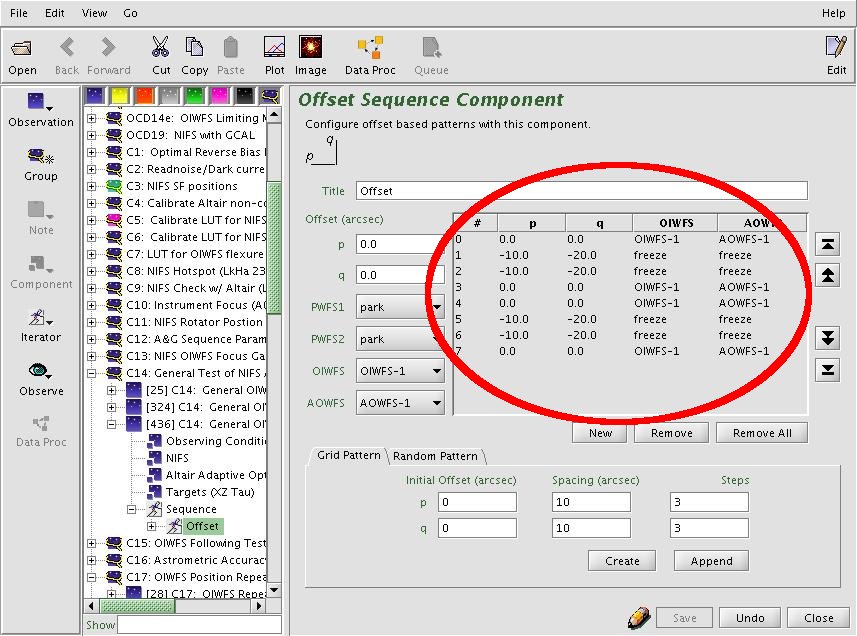![[NIFS home]](nifsimage.gif)
| You are in: Instruments > NIFS > Performance and Use > Observing Strategies |
![[NIFS home]](nifsimage.gif)
|
NIFS Observing Strategies and Guidelines |
NIFS can be used with different combinations of guide stars. The most frequent mode will be NIFS+Altair. However, if your observation is long and when a suitable guide star (within < 48" and K > ~14mag) is available, it is highly recommend to use NIFS+Altair+OIWFS to compensate flexure of the combined telescope and instrument. If there is no suitable guide star available for Altair (e.g., no nearby bright star AND your target is too faint or an extended object), NIFS can be used with PWFS stars.
Here guidelines to select good guide stars are summarized. Note that the guide star brightness limits are for cloudless nights (50% CC) and optimal seeing (IQ ≤ 70%). Altair can guide on fainter stars (to R~15 mag for A0 stars) which will result in poor correction.
| separation from the science target |
guide star brightness | |
| Altair | < 25" | R <~12 mag (optimal) |
| OIWFS | < 48" | K <~ 14.5 mag |
| P1WFS P2WFS |
3.5' to 7' 3.5' to 6.'5 |
R <~ 12 mag R <~ 15.5 mag |
Two occulting disks are available in NIFS (0."2, and 0."5 diameter). Attenuation of light from the target will greatly depend on how well the object is aligned behind the coronagraph of choice. As a result, every coronagraphic observation should have a dedicated acquisition sequence. For good suppression of scattered light, your target should be aligned to the center better than ~10% of diameter of the occulting disk. For an example of coronagraphic observation acquisition sequence, check coronagraphic observation samples in the NIFS OT Library (xml file).
For smaller occulting disks, aware that acquisition time will take much longer to get your target reasonably aligned behind the occulting disks.
If your coronagraphic observation requires sky frames between target frames, we strongly recommend that you only use the larger, 0."5 occulting disk for your observations. When offsetting to sky, it is much more difficult to keep a target adequately centered to <0."02 behind the small 0."2 occulting disk. Using the 0."5 disk will result in less observing overhead because of target centering and will result in more efficient observations. For sky offsetting, your phase II file needs to set guide stars to the "freeze" state for your sky offset position. This means that you need to set AOWFS and OIWFS to "freeze" if you are observing with NIFS+Altair+OIWFS (see the example below).

Polarimetric observations are not yet available.
Current estimates of overheads associated with each new science target (for target acquisition, telescope, WFS and instrument re-configuration etc) are 15 min for a NIFS+Altair observation, 20 minutes for setup for NIFS+Altair plus an OIWFS star, and 25 min for coronagraphy. For automated sequences of exposures (dither patterns) the estimated on-source efficiency is ~40% (i.e. 60% of the elapsed time is used for detector readout, telescope offsetting, WFS re-acquisition etc). This estimate is quite realistic for a typical target->sky->target->sky... observations. Note that extra observing overheads are needed for observations in the low noise readout modes. Standard "bright object" readout requires 5 seconds per image, medium read mode is 21 seconds per image, and the "faint object" readmode, which provides the optimal 6e- readnoise, requires 85 seconds to readout each frame. Also, readout overheads accumulate for every coadd, so a "faint object" observation that has 8 coadds will have 8x85 = 680seconds of readout overhead! This is not recommended. For optimal efficiency, it is best to chose a readmode based on the brightness of your target and the length of the individual exposures.
| Readmode | read noise | readout time (per coadd) |
| Bright source | 18 e- | 5.3 sec |
| Medium source | 9 e- | 21.2 sec |
| Faint source |
6 e- | 84.9 sec |
Acquisition of an object behind an occulting disk takes longer than non-coronagraphic observations especially for a smaller occulting disk. The OT assumes an overhead of 25 min for setup and this is realistic for coronagraphic observations.
Additional overhead of grating change (~60 sec) and telescope offset (~30 sec) should be taken into account also.
A new OT for 2006B CfP should have all the above NIFS overheads
properly handled, then "Timeline" in the "Basic Sequence Component"
should be close to the actual exection time (i.e., wall clock time).
Last update 1 March 2006; Inseok Song